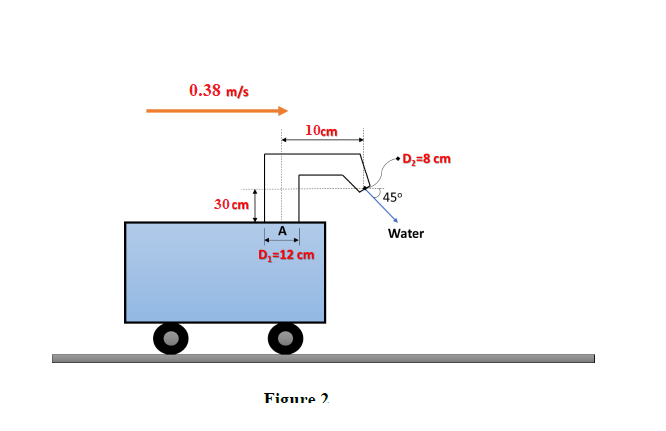A fire robot is designed as shown in Figure 2 to fight the fire while it moves with 0.38 m/s constant velocity. A reducing elbow is used to deflect water flow in a horizontal pipe downward 45 degree while accelerating the water. The water that comes from the tank is discharged at a rate of 6.03 kg/s to the atmosphere. The diameter of the pipe is D1=12 cm at the inlet (Point A) and D2=8 cm at the outlet. The weight of the elbow and the water in it is considered to be negligible. a) Determine the bending moment acting the base of the pipe (Point A) b) How would you make the moment at Point A zero? What is your suggestion? c) Determine the force that needs to be applied to the fire robot to prevent acceleration? Should this force be exerted by the brakes to slow down? Or is it by the motor for extra power? d) Calculate the extra mass that should be loaded on the fire robot so that there is no change in the friction force between the robot and the ground. (neglect the water weight loss due to discharging)
A fire robot is designed as shown in Figure 2 to fight the fire while it moves with 0.38 m/s constant velocity. A reducing elbow is used to deflect water flow in a horizontal pipe downward 45 degree while accelerating the water. The water that comes from the tank is discharged at a rate of 6.03 kg/s to the atmosphere. The diameter of the pipe is D1=12 cm at the inlet (Point A) and D2=8 cm at the outlet. The weight of the elbow and the water in it is considered to be negligible.
a) Determine the bending moment acting the base of the pipe (Point A)
b) How would you make the moment at Point A zero? What is your suggestion?
c) Determine the force that needs to be applied to the fire robot to prevent acceleration? Should this force be exerted by the brakes to slow down? Or is it by the motor for extra power?
d) Calculate the extra mass that should be loaded on the fire robot so that there is no change in the friction force between the robot and the ground. (neglect the water weight loss due to discharging)

Step by step
Solved in 5 steps









